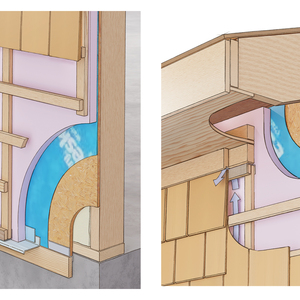Wood beam equivilant in steel?
doing a rough estimate on a job.
Client wants to have a steel beam instead of the specified 4 X 2″X 10″ or 3 X 2″X12″ built up beam. This is a 13’8″ beam, suporting a flat roof at aprox mid span (roof span=25′,Montreal). I will get an engineer to sign off but I need an aproximate size for the steel so that i can do the rough estimate. Thanks as always for any and all input.



















Replies
In my experience, steel is significantly smaller and roughly equal in cost to glulams or other engineered beams. Steel will be smaller and more expensive than your sawn-lumber options, and you will find that you have several options in terms of beam size and weight, i.e. there will probably be a lighter-gauge 8" web and a heavier-gauge 6" web that would both work. Steel spans have been discussed here many times, and there don't seem to be readily accessible tables that compare steel and wood. The good news is that your engineer probably has software that shows all sorts of options all at once. My guess is that you should budget for 250-350 lbs.
Edited 10/3/2006 10:16 am by davidmeiland
OK, for rough estimating, let's try this: Assume Select Structural timber grade with Fb = 1600 psi, and to make it simpler, a span of 14 ft. Then a little algebra to solve for the maximum uniformly distributed load such a beam can carry:
S = M/Fb, so M = S*Fb. S is lower for the 2x10's at 85.564 in^3 than for the 2x12's, so using that we get M = 136,902.4 in-lb = 11409 ft-lb.
M = WL/8, so solving for W we get W = 8M/L = 8*11409/14 = 6520 pounds, say 6.5 kip.
Looking in the little span table excerpt in Parker/Ambrose, the lowest entry for 14 ft. span is w8x10, at 8.9 kip. 140 lbs. of steel should be plenty.
Of course this is for rough estimation only, and worth approximately what you paid for it. ;-)
-- J.S.
He wrote that it will be "supporting a flat roof at approximately mid-span" which I take to mean that there's a point load. I thought he might end up with a W8x18.
I thought it through in terms of distributed load, because that's what the handy steel tables use. Given that both beams are uniform along their length, it seems to me that equivalent strength for distributed load should mean equivalent strength for any other loading arrangement. Or at least close enough for estimating.
I don't have the time to do the math right now, but the way to go would be to figure the maximum load the four 2x10's could hold as a center point load, and then figure what you'd need to do that with steel. Perhaps one of the real engineers here will step in on this. If not, hopefully the OP will report back what his engineer specified.
-- J.S.
I am a structural engineer, but a lazy one. I think you did a fine job with a quick analysis.
One good source of information is TrusJoist MacMillan's site, where they show load capabilities for their LVL man-made timbers.
You can readily find the loadbearing capacity of a 1.75 x 9.25 LVL, given a span. It will be given in plf, and their tables will show whether total load or deflection is the limiting factor.
With this figure, I would multiply it by 4, and find the equivalent wide flange steel member that could handle the same. That would be nice and conservative, as the LVL has a better capacity for load than most #1 structural timber.
To size the steel, you'll need something like SpanCalc, or do it the old fashioned way. When I learned all this, we used slide rules.
My steel supplier would size this member for me in one quick phone call.
I am a structural engineer, but a lazy one
In engineering school they told us that good engineers were lazy and cheap...always looking for the simplest, least expensive solution to the problem.
Are you cheap too?
There's no one cheaper!
Then you must be an excellent engineer....
Thanks -- I'm not a structural engineer, just a guy who read one engineering book once.... ;-)
-- J.S.